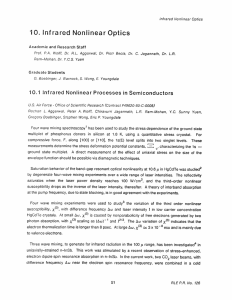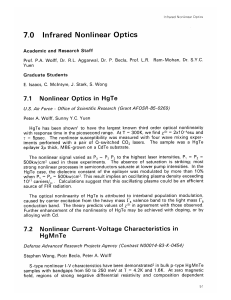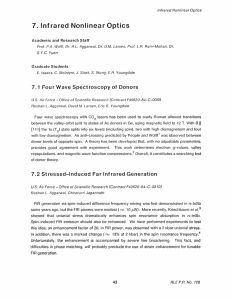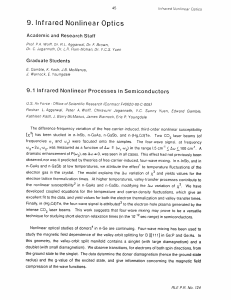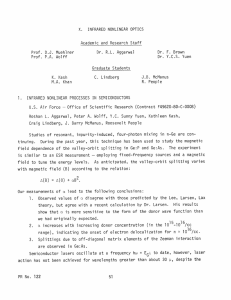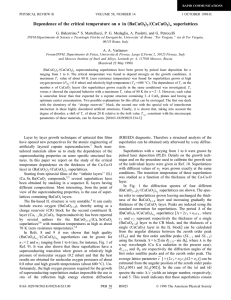7.0 Infrared Nonlinear Optics 7.1
advertisement
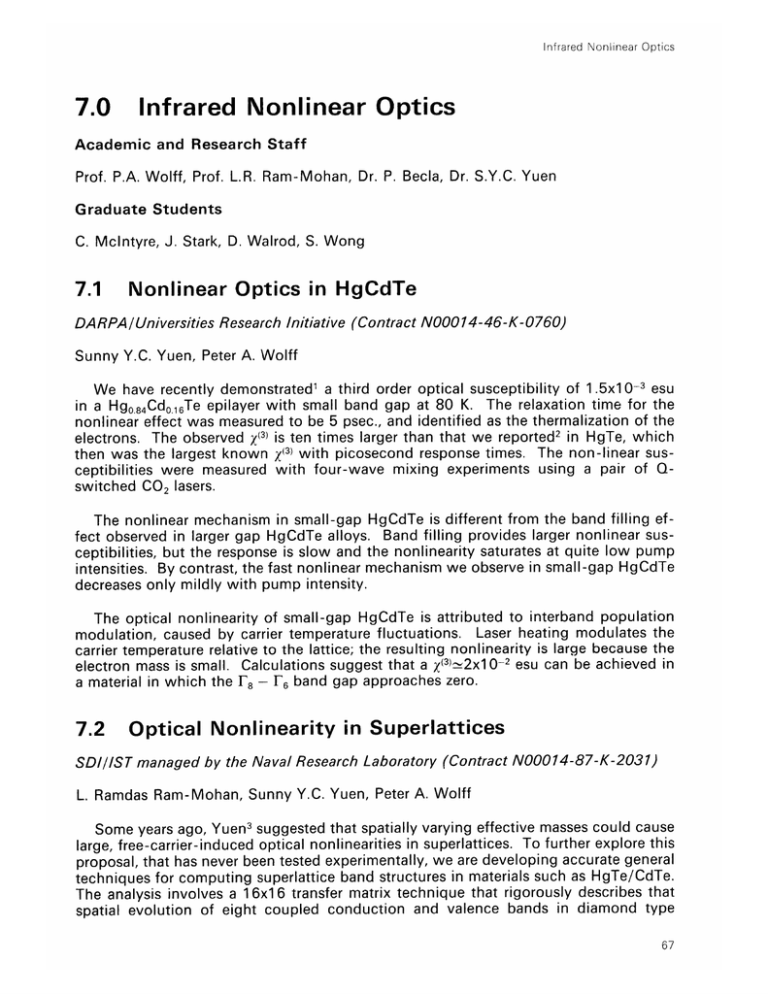
Infrared Nonlinear Optics 7.0 Infrared Nonlinear Optics Academic and Research Staff Prof. P.A. Wolff, Prof. L.R. Ram-Mohan, Dr. P. Becla, Dr. S.Y.C. Yuen Graduate Students C. Mcintyre, J. Stark, D. Walrod, S. Wong 7.1 Nonlinear Optics in HgCdTe DARPA/Universities Research Initiative (Contract NOOO14-46-K-0760) Sunny Y.C. Yuen, Peter A. Wolff We have recently demonstrated' a third order optical susceptibility of 1.5x10 -3 esu in a Hg 0.84 Cd0.16 Te epilayer with small band gap at 80 K. The relaxation time for the nonlinear effect was measured to be 5 psec., and identified as the thermalization of the electrons. The observed Z(3 is ten times larger than that we reported 2 in HgTe, which then was the largest known X(3) with picosecond response times. The non-linear susceptibilities were measured with four-wave mixing experiments using a pair of Qswitched CO 2 lasers. The nonlinear mechanism in small-gap HgCdTe is different from the band filling effect observed in larger gap HgCdTe alloys. Band filling provides larger nonlinear susceptibilities, but the response is slow and the nonlinearity saturates at quite low pump intensities. By contrast, the fast nonlinear mechanism we observe in small-gap HgCdTe decreases only mildly with pump intensity. The optical nonlinearity of small-gap HgCdTe is attributed to interband population modulation, caused by carrier temperature fluctuations. Laser heating modulates the carrier temperature relative to the lattice; the resulting nonlinearity is large because the electron mass is small. Calculations suggest that a Z(3')2x10- 2 esu can be achieved in a material in which the F 8 - F 6 band gap approaches zero. 7.2 Optical Nonlinearity in Superlattices SDI/IST managed by the Naval Research Laboratory (Contract N00014-87-K-2031) L. Ramdas Ram-Mohan, Sunny Y.C. Yuen, Peter A. Wolff Some years ago, Yuen 3 suggested that spatially varying effective masses could cause large, free-carrier-induced optical nonlinearities in superlattices. To further explore this proposal, that has never been tested experimentally, we are developing accurate general techniques for computing superlattice band structures in materials such as HgTe/CdTe. The analysis involves a 16x16 transfer matrix technique that rigorously describes that spatial evolution of eight coupled conduction and valence bands in diamond type Infrared Nonlinear Optics semiconductors. The program involves a novel routine for calculating the exponential of a 16x16 matrix (8 wave functions and their derivatives). Preliminary calculations give excellent agreement with previous superlattice band structures. These techniques will next be used to compute superlattice dielectric constants and optical nonlinearities. In optimizing the latter, we will be guided by previous studies of the free-carrier-induced optical nonlinearities of semiconductors which suggest that the largest nonlinearities occur when the character of the carrier wave functions changes rapidly with temperature .4 This theoretical work is being performed in collaboration with NRL, which is doing experimental studies of carrier dynamics and band structure in HgTe/CdTe superlattices. 7.3 Negative Magnetoresistance and Current-Voltage Characteristics of HgTe/CdTe superlattices. 7.4 Negative Magnetoresistance and Current-Voltage Characteristics of HgMnTe DARPA Universities Research Initiative (Contract N00014-46-K-0760) Stephen Wong, Piotr Becla, Peter A. Wolff At low temperature, p-type HgMnTe has an enormous negative magnetoresistance; 5 in some cases magnetic fields of 6 T decrease the resistivity by factors as large as 105 - 106 . This dramatic effect has been ascribed to "magnetic boil-off" or a fieldinduced metal-insulator transition. To explore the mechanisms of the large conductivity change, we have performed pulsed, high field measurements of current-voltage characteristics in p-HgMnTe. Avalanche breakdown is observed in large electric fields; short pulse experiments assure that the effect is electronic rather that thermal. The form of the i-v curves precludes the boil-off mechanism, as also implied by low temperature conductivity measurements .6 Theoretical calculations suggest that magnetic field-induced acceptor overlap, resulting from the unusual valence splittings of p-HgMnTe, could cause the metalinsulator transition. This hypothesis will be tested with higher field (to 19 T) magnetoresistance measurements. Unusual non-linear optic effects are also anticipated in p-HgMnTe. References 1 S.Y. Yuen, P.A. Wolff, K.A. Harris, J.W. Cook, Jr., and J.F. Schetzina, J. Vac. Sci. Tech. In press. 2 P.A. Wolff, S.Y. Yuen, K.A. Harris, J.W. Cook, Jr., and J.F. Schetzina, App. Phys. Lett. 50:1858 (1987). 3 S.Y. Yuen, Appl. Phys. Lett. 42:331 (1983). 68 RLE Progress Report Number 130 Infrared Nonlinear Optics 4 P.A. Wolff, S.Y. Yuen, and G.A. Thomas, Solid State Commun. 60:645 (1986). 5 A. Mycielski and J. Mycielski, J. Phys. Soc. Japan 49, Suppl. A:807 (1980). 6 T. Wojtowicz, T. Dietl, A. Sawicki, W. Plesiewicz, and J. Jaroszynski, Phys. Rev. Lett. 56:2419 (1986). Professor Marc A. Kastner and Research Assistant Jerome C. Licini 70 RLE Progress Report Number 130

